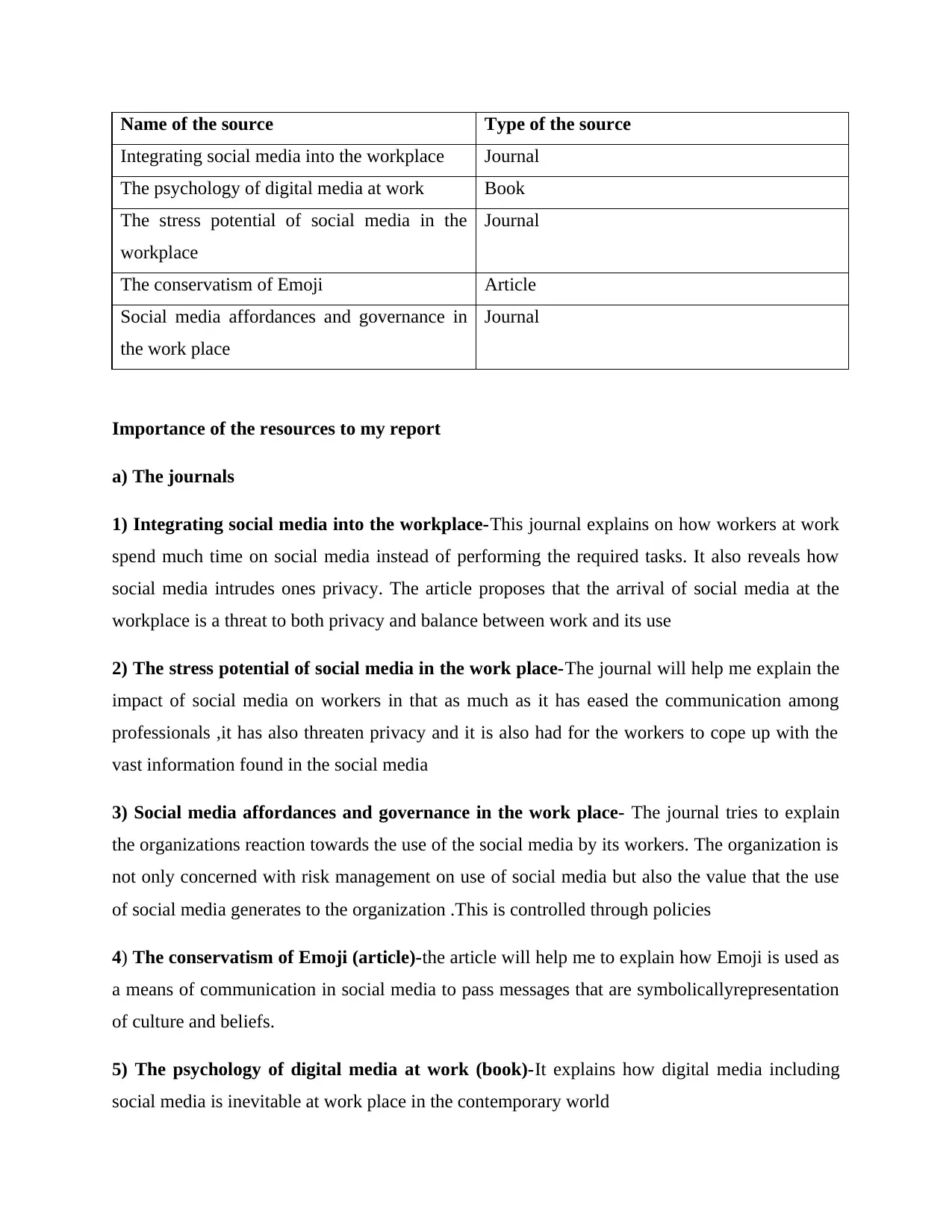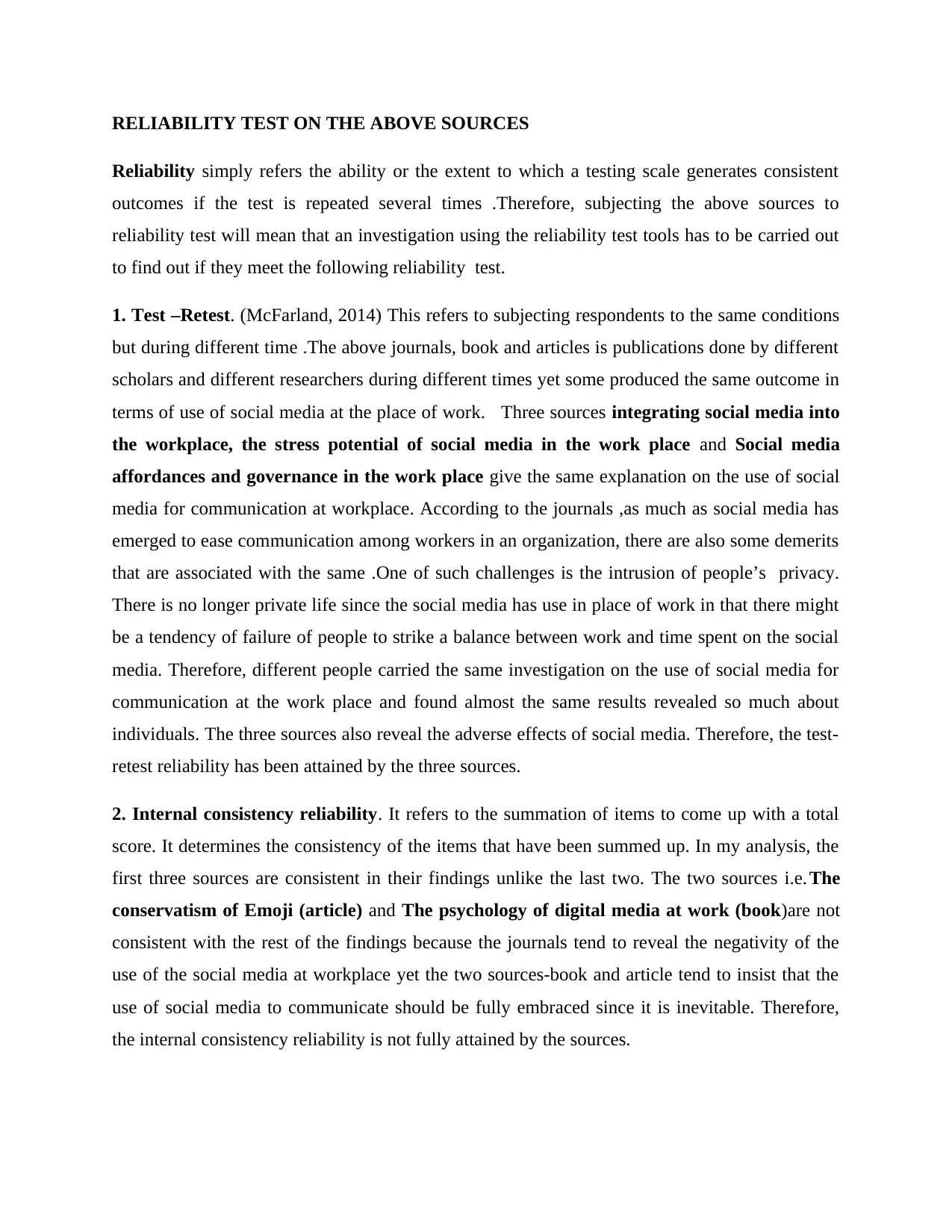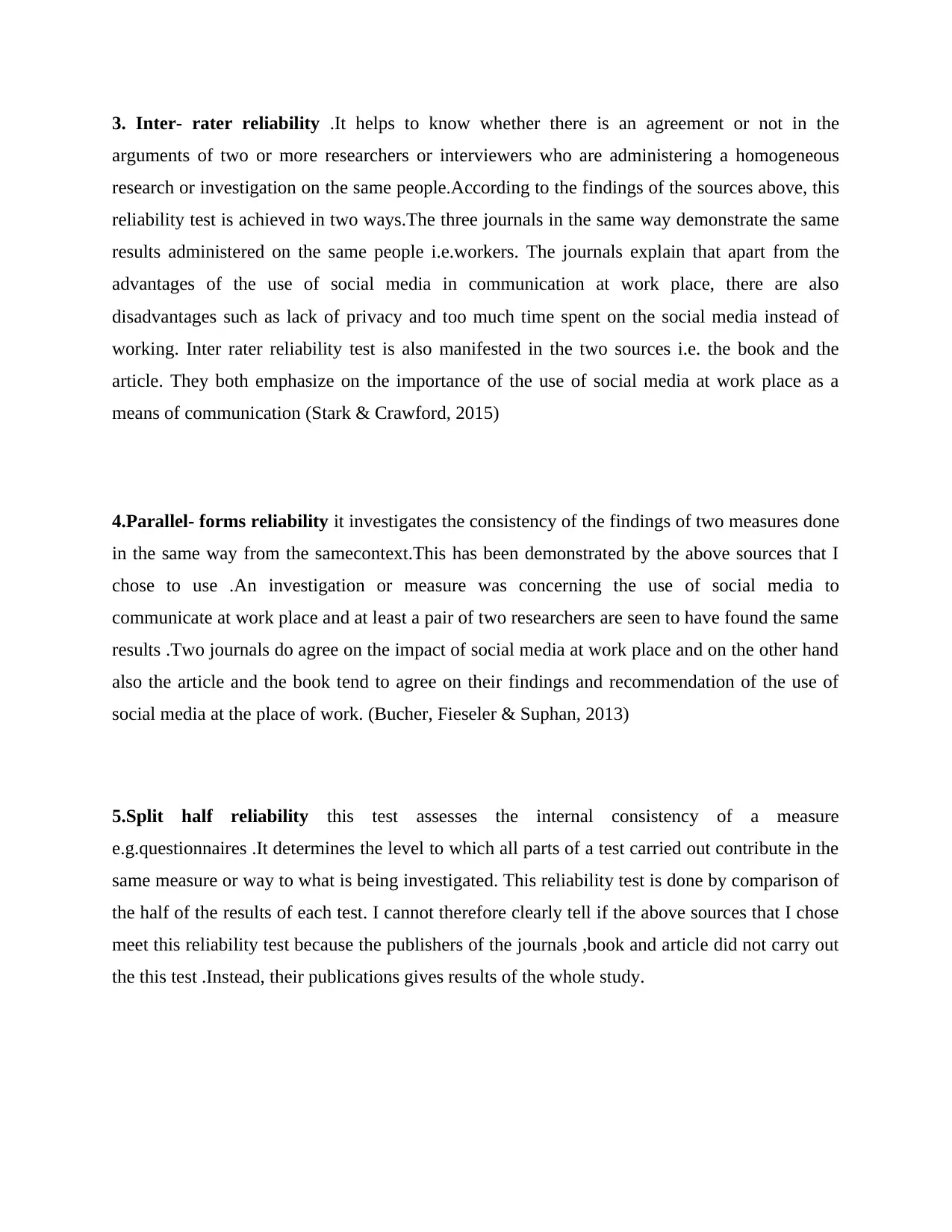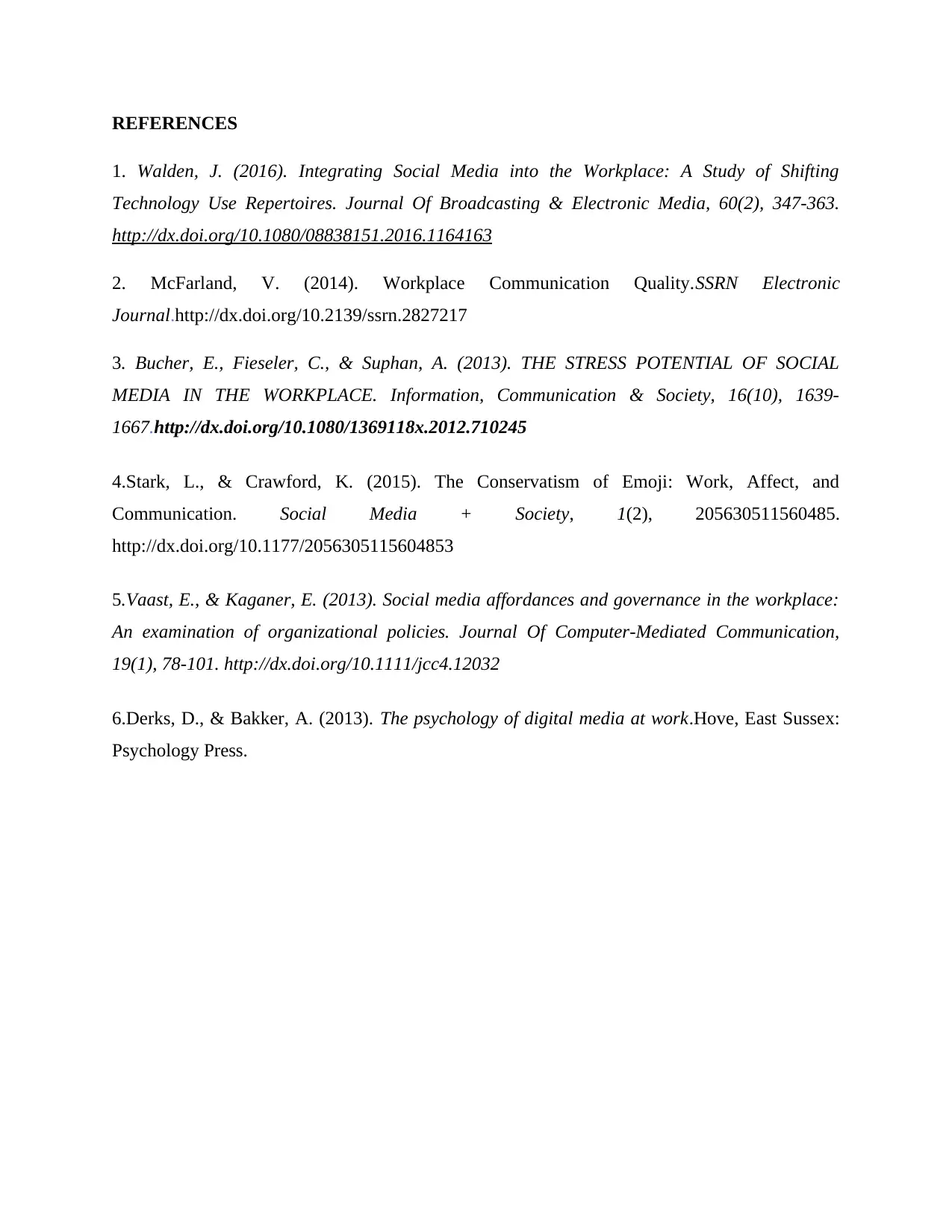Analysis of Source Reliability: Social Media in the Workplace
VerifiedAdded on 2020/03/23
|5
|1398
|57
Report
AI Summary
This report assesses the reliability of several sources concerning the use of social media in the workplace. The sources include journals, a book, and an article, each addressing different aspects of social media's impact, such as its intrusion on privacy, its stress potential, and organizational governance. The report employs various reliability tests, including test-retest, internal consistency, inter-rater reliability, parallel-forms reliability, and split-half reliability, to evaluate the consistency and validity of the information presented in each source. The analysis reveals that while most sources demonstrate a high level of reliability across multiple tests, some inconsistencies arise, particularly in how they address the overall impact of social media. The report concludes that the sources generally meet the reliability criteria, providing valuable insights into the effects of social media in professional environments.

Name of the source Type of the source
Integrating social media into the workplace Journal
The psychology of digital media at work Book
The stress potential of social media in the
workplace
Journal
The conservatism of Emoji Article
Social media affordances and governance in
the work place
Journal
Importance of the resources to my report
a) The journals
1) Integrating social media into the workplace-This journal explains on how workers at work
spend much time on social media instead of performing the required tasks. It also reveals how
social media intrudes ones privacy. The article proposes that the arrival of social media at the
workplace is a threat to both privacy and balance between work and its use
2) The stress potential of social media in the work place-The journal will help me explain the
impact of social media on workers in that as much as it has eased the communication among
professionals ,it has also threaten privacy and it is also had for the workers to cope up with the
vast information found in the social media
3) Social media affordances and governance in the work place- The journal tries to explain
the organizations reaction towards the use of the social media by its workers. The organization is
not only concerned with risk management on use of social media but also the value that the use
of social media generates to the organization .This is controlled through policies
4) The conservatism of Emoji (article)-the article will help me to explain how Emoji is used as
a means of communication in social media to pass messages that are symbolicallyrepresentation
of culture and beliefs.
5) The psychology of digital media at work (book)-It explains how digital media including
social media is inevitable at work place in the contemporary world
Integrating social media into the workplace Journal
The psychology of digital media at work Book
The stress potential of social media in the
workplace
Journal
The conservatism of Emoji Article
Social media affordances and governance in
the work place
Journal
Importance of the resources to my report
a) The journals
1) Integrating social media into the workplace-This journal explains on how workers at work
spend much time on social media instead of performing the required tasks. It also reveals how
social media intrudes ones privacy. The article proposes that the arrival of social media at the
workplace is a threat to both privacy and balance between work and its use
2) The stress potential of social media in the work place-The journal will help me explain the
impact of social media on workers in that as much as it has eased the communication among
professionals ,it has also threaten privacy and it is also had for the workers to cope up with the
vast information found in the social media
3) Social media affordances and governance in the work place- The journal tries to explain
the organizations reaction towards the use of the social media by its workers. The organization is
not only concerned with risk management on use of social media but also the value that the use
of social media generates to the organization .This is controlled through policies
4) The conservatism of Emoji (article)-the article will help me to explain how Emoji is used as
a means of communication in social media to pass messages that are symbolicallyrepresentation
of culture and beliefs.
5) The psychology of digital media at work (book)-It explains how digital media including
social media is inevitable at work place in the contemporary world
Paraphrase This Document
Need a fresh take? Get an instant paraphrase of this document with our AI Paraphraser

RELIABILITY TEST ON THE ABOVE SOURCES
Reliability simply refers the ability or the extent to which a testing scale generates consistent
outcomes if the test is repeated several times .Therefore, subjecting the above sources to
reliability test will mean that an investigation using the reliability test tools has to be carried out
to find out if they meet the following reliability test.
1. Test –Retest. (McFarland, 2014) This refers to subjecting respondents to the same conditions
but during different time .The above journals, book and articles is publications done by different
scholars and different researchers during different times yet some produced the same outcome in
terms of use of social media at the place of work. Three sources integrating social media into
the workplace, the stress potential of social media in the work place and Social media
affordances and governance in the work place give the same explanation on the use of social
media for communication at workplace. According to the journals ,as much as social media has
emerged to ease communication among workers in an organization, there are also some demerits
that are associated with the same .One of such challenges is the intrusion of people’s privacy.
There is no longer private life since the social media has use in place of work in that there might
be a tendency of failure of people to strike a balance between work and time spent on the social
media. Therefore, different people carried the same investigation on the use of social media for
communication at the work place and found almost the same results revealed so much about
individuals. The three sources also reveal the adverse effects of social media. Therefore, the test-
retest reliability has been attained by the three sources.
2. Internal consistency reliability. It refers to the summation of items to come up with a total
score. It determines the consistency of the items that have been summed up. In my analysis, the
first three sources are consistent in their findings unlike the last two. The two sources i.e. The
conservatism of Emoji (article) and The psychology of digital media at work (book)are not
consistent with the rest of the findings because the journals tend to reveal the negativity of the
use of the social media at workplace yet the two sources-book and article tend to insist that the
use of social media to communicate should be fully embraced since it is inevitable. Therefore,
the internal consistency reliability is not fully attained by the sources.
Reliability simply refers the ability or the extent to which a testing scale generates consistent
outcomes if the test is repeated several times .Therefore, subjecting the above sources to
reliability test will mean that an investigation using the reliability test tools has to be carried out
to find out if they meet the following reliability test.
1. Test –Retest. (McFarland, 2014) This refers to subjecting respondents to the same conditions
but during different time .The above journals, book and articles is publications done by different
scholars and different researchers during different times yet some produced the same outcome in
terms of use of social media at the place of work. Three sources integrating social media into
the workplace, the stress potential of social media in the work place and Social media
affordances and governance in the work place give the same explanation on the use of social
media for communication at workplace. According to the journals ,as much as social media has
emerged to ease communication among workers in an organization, there are also some demerits
that are associated with the same .One of such challenges is the intrusion of people’s privacy.
There is no longer private life since the social media has use in place of work in that there might
be a tendency of failure of people to strike a balance between work and time spent on the social
media. Therefore, different people carried the same investigation on the use of social media for
communication at the work place and found almost the same results revealed so much about
individuals. The three sources also reveal the adverse effects of social media. Therefore, the test-
retest reliability has been attained by the three sources.
2. Internal consistency reliability. It refers to the summation of items to come up with a total
score. It determines the consistency of the items that have been summed up. In my analysis, the
first three sources are consistent in their findings unlike the last two. The two sources i.e. The
conservatism of Emoji (article) and The psychology of digital media at work (book)are not
consistent with the rest of the findings because the journals tend to reveal the negativity of the
use of the social media at workplace yet the two sources-book and article tend to insist that the
use of social media to communicate should be fully embraced since it is inevitable. Therefore,
the internal consistency reliability is not fully attained by the sources.

3. Inter- rater reliability .It helps to know whether there is an agreement or not in the
arguments of two or more researchers or interviewers who are administering a homogeneous
research or investigation on the same people.According to the findings of the sources above, this
reliability test is achieved in two ways.The three journals in the same way demonstrate the same
results administered on the same people i.e.workers. The journals explain that apart from the
advantages of the use of social media in communication at work place, there are also
disadvantages such as lack of privacy and too much time spent on the social media instead of
working. Inter rater reliability test is also manifested in the two sources i.e. the book and the
article. They both emphasize on the importance of the use of social media at work place as a
means of communication (Stark & Crawford, 2015)
4.Parallel- forms reliability it investigates the consistency of the findings of two measures done
in the same way from the samecontext.This has been demonstrated by the above sources that I
chose to use .An investigation or measure was concerning the use of social media to
communicate at work place and at least a pair of two researchers are seen to have found the same
results .Two journals do agree on the impact of social media at work place and on the other hand
also the article and the book tend to agree on their findings and recommendation of the use of
social media at the place of work. (Bucher, Fieseler & Suphan, 2013)
5.Split half reliability this test assesses the internal consistency of a measure
e.g.questionnaires .It determines the level to which all parts of a test carried out contribute in the
same measure or way to what is being investigated. This reliability test is done by comparison of
the half of the results of each test. I cannot therefore clearly tell if the above sources that I chose
meet this reliability test because the publishers of the journals ,book and article did not carry out
the this test .Instead, their publications gives results of the whole study.
arguments of two or more researchers or interviewers who are administering a homogeneous
research or investigation on the same people.According to the findings of the sources above, this
reliability test is achieved in two ways.The three journals in the same way demonstrate the same
results administered on the same people i.e.workers. The journals explain that apart from the
advantages of the use of social media in communication at work place, there are also
disadvantages such as lack of privacy and too much time spent on the social media instead of
working. Inter rater reliability test is also manifested in the two sources i.e. the book and the
article. They both emphasize on the importance of the use of social media at work place as a
means of communication (Stark & Crawford, 2015)
4.Parallel- forms reliability it investigates the consistency of the findings of two measures done
in the same way from the samecontext.This has been demonstrated by the above sources that I
chose to use .An investigation or measure was concerning the use of social media to
communicate at work place and at least a pair of two researchers are seen to have found the same
results .Two journals do agree on the impact of social media at work place and on the other hand
also the article and the book tend to agree on their findings and recommendation of the use of
social media at the place of work. (Bucher, Fieseler & Suphan, 2013)
5.Split half reliability this test assesses the internal consistency of a measure
e.g.questionnaires .It determines the level to which all parts of a test carried out contribute in the
same measure or way to what is being investigated. This reliability test is done by comparison of
the half of the results of each test. I cannot therefore clearly tell if the above sources that I chose
meet this reliability test because the publishers of the journals ,book and article did not carry out
the this test .Instead, their publications gives results of the whole study.
⊘ This is a preview!⊘
Do you want full access?
Subscribe today to unlock all pages.

Trusted by 1+ million students worldwide

Conclusion
In conclusion therefore, after carrying out the five reliability test on each of the sources above, it
is evident that all the sources have been able to meet these tests. I can therefore say that the
above sources demonstrate high level of reliability
In conclusion therefore, after carrying out the five reliability test on each of the sources above, it
is evident that all the sources have been able to meet these tests. I can therefore say that the
above sources demonstrate high level of reliability
Paraphrase This Document
Need a fresh take? Get an instant paraphrase of this document with our AI Paraphraser

REFERENCES
1. Walden, J. (2016). Integrating Social Media into the Workplace: A Study of Shifting
Technology Use Repertoires. Journal Of Broadcasting & Electronic Media, 60(2), 347-363.
http://dx.doi.org/10.1080/08838151.2016.1164163
2. McFarland, V. (2014). Workplace Communication Quality.SSRN Electronic
Journal.http://dx.doi.org/10.2139/ssrn.2827217
3. Bucher, E., Fieseler, C., & Suphan, A. (2013). THE STRESS POTENTIAL OF SOCIAL
MEDIA IN THE WORKPLACE. Information, Communication & Society, 16(10), 1639-
1667.http://dx.doi.org/10.1080/1369118x.2012.710245
4.Stark, L., & Crawford, K. (2015). The Conservatism of Emoji: Work, Affect, and
Communication. Social Media + Society, 1(2), 205630511560485.
http://dx.doi.org/10.1177/2056305115604853
5.Vaast, E., & Kaganer, E. (2013). Social media affordances and governance in the workplace:
An examination of organizational policies. Journal Of Computer-Mediated Communication,
19(1), 78-101. http://dx.doi.org/10.1111/jcc4.12032
6.Derks, D., & Bakker, A. (2013). The psychology of digital media at work.Hove, East Sussex:
Psychology Press.
1. Walden, J. (2016). Integrating Social Media into the Workplace: A Study of Shifting
Technology Use Repertoires. Journal Of Broadcasting & Electronic Media, 60(2), 347-363.
http://dx.doi.org/10.1080/08838151.2016.1164163
2. McFarland, V. (2014). Workplace Communication Quality.SSRN Electronic
Journal.http://dx.doi.org/10.2139/ssrn.2827217
3. Bucher, E., Fieseler, C., & Suphan, A. (2013). THE STRESS POTENTIAL OF SOCIAL
MEDIA IN THE WORKPLACE. Information, Communication & Society, 16(10), 1639-
1667.http://dx.doi.org/10.1080/1369118x.2012.710245
4.Stark, L., & Crawford, K. (2015). The Conservatism of Emoji: Work, Affect, and
Communication. Social Media + Society, 1(2), 205630511560485.
http://dx.doi.org/10.1177/2056305115604853
5.Vaast, E., & Kaganer, E. (2013). Social media affordances and governance in the workplace:
An examination of organizational policies. Journal Of Computer-Mediated Communication,
19(1), 78-101. http://dx.doi.org/10.1111/jcc4.12032
6.Derks, D., & Bakker, A. (2013). The psychology of digital media at work.Hove, East Sussex:
Psychology Press.
1 out of 5
Related Documents
Your All-in-One AI-Powered Toolkit for Academic Success.
+13062052269
info@desklib.com
Available 24*7 on WhatsApp / Email
![[object Object]](/_next/static/media/star-bottom.7253800d.svg)
Unlock your academic potential
Copyright © 2020–2025 A2Z Services. All Rights Reserved. Developed and managed by ZUCOL.




